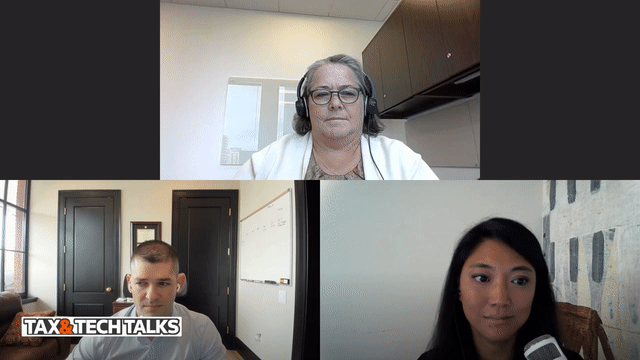Each year, more than 40 million Schedule K-1 (Form 1065) are sent to US taxpayers, reporting income and other financial information stemming from their participation in partnerships, S corporations, and trusts.
Unlike W-2 forms and other IRS-mandated documentation, however, K-1s needn’t be produced in a standard format, so they come in a variety of formats and may include unstructured data, free-form text, footnotes, statements, and disclosures. As a result, organizations’ tax compliance specialists must pore over, extract, and process disparate information in an arduous, manual process that is time-consuming and error-prone.
Thankfully, one of the newest uses of artificial intelligence in tax reporting addresses this pain point, eliminates manual data entry, and frees tax professionals to perform more valuable and rewarding analytical and strategic work.
_______________________________________________________
Watch the entire episode
Tax & Tech Talks: How AI and Machine Learning Can Help With K-1s
Subscribe to Tax & Tech Talks podcast on Spotify, Libsynpro, and Apple Podcast apps.
_______________________________________________________
Tax experts from Crowe and Thomson Reuters discussed this issue in a new episode of the Tax & Tech Talks podcast titled, How AI and Machine Learning Can Help With K-1s. The discussion features:
- Bianca Kuijper, Director of Direct Tax, Transfer Pricing & Checkpoint Propositions at Thomson Reuters.
- Geralyn Hurd, Tax Strategy & Transformation Leader at Crowe.
- Justin Bass, Chief Data Science Officer at Crowe.
A Complex Undertaking
For tax reporting purposes, K-1s provide organizations with information on their earnings, losses, deductions, and credits that resulted from their interests in partnerships and pass-through entities such as S corporations and trusts.
“Unfortunately, the K-1 has a reputation for arriving late,” Investopedia reports. “In fact, it’s often one of the last tax documents to be received by the taxpayer. The most common reasons are the complexity of calculating partners’ shares and the need to individually calculate every partner’s K-1.”
In addition, “the Schedule K-1 can be quite complex and require multiple entries on the taxpayer’s federal return, including entries on the Schedule A, Schedule B, Schedule D, and, in some cases, Form 678,” Investopedia says. “That’s because a partner can earn several types of income on Schedule K-1, including rental income from a partnership’s real estate holdings and income from bond interest and stock dividends.”
- In the podcast, Hurd described several other reasons the K-1 reporting process is difficult:
- A Schedule K-1 can be from 15 pages to several hundred pages long, and taxpayers such as large corporations and institutional investors are common partners, shareholders, or trustees in hundreds of entities.
- The information disclosed on a K-1 may have state, federal, and international tax implications.
- The various types of K-1 recipients—individuals, corporations, limited liability companies, tax-exempt entities, and others—have different reporting requirements.
- Tiered partnership structures create additional complexity.
Traditionally, this has required tax specialists to manually review each K-1 to identify, extract, and log the relevant information. “All these forms have a lot of free-form texts, and we need to derive different information depending on different scenarios,” Hurd says. “This requires a person going through and saying, ‘I do need this. I don’t need that. This is garbage, but I do want that. I’m missing this because I can’t find it within the K-1.’ “
“And then there’s also a chance that we’ll need to aggregate certain types of data,” she added. “It really (requires) a lot of time and money to dissect and extract key data elements from the form.”
In a large organization, managing hundreds of K-1s annually can be a full-time job for several people with tax expertise—leaving them little time for more substantive work, Hurd says. “They’re not getting time (to address) tax positions, filing responsibilities, and make sure they’re fully in compliance,” she notes. “That analytics piece is so critical from a risk and opportunity perspective, but we’re spending so much time just keying in data that we never quite get to that.”
An Automated Solution
Thomson Reuters K-1 Analyzer is an AI-powered solution that addresses this complex tax compliance workstream. Created by Crowe and included in the Thomson Reuters tax software suite, K-1 Analyzer uses artificial intelligence and machine learning to identify, extract, aggregate, and standardize non-structured information from K-1s so it can be reviewed and analyzed.
This reduces the time needed to process a K-1 form from up to an hour to about 15 seconds, Hurd says. “Somebody could drop several hundred into the machine, go have lunch, come back, and start to do their reviews. You’ve just completed weeks’ worth of work.”
Crowe’s data scientists trained their machine-learning model on hundreds of thousands of K-1s—creating a tool that knows what to extract, where the data needs to be recorded, and how specific information is referenced within the document, Bass explains. “That 10 years of data gave us enough examples to find those patterns and have the machine learning create that map,” he says.
The key to the research was blending sophisticated data science with tax expertise, Hurd says. “We have data scientists along with product developers, product engineers, software engineers, and tax people coming together to make the foundation of the models,” she says. “We have the benefit of lots of years of experience with tax.”
Bass agrees: “The collaboration here is really important, especially as we look to improve the machine learning models in all areas of the application. You need to continue to get that feedback from the tax professionals, as well as the software developers because it’s not just what does the data tell us, but how humans interpret it.”
For more articles to help you transform your tax department, read our latest blog posts:
K-1 Aggregation and International Filing Requirements white paper
AI-Enhance Processes and Decision-Making Are Revolutionizing Corporate Tax Departments
How Tech Can Help You Navigate the New Tax Rules and Tax Trends





